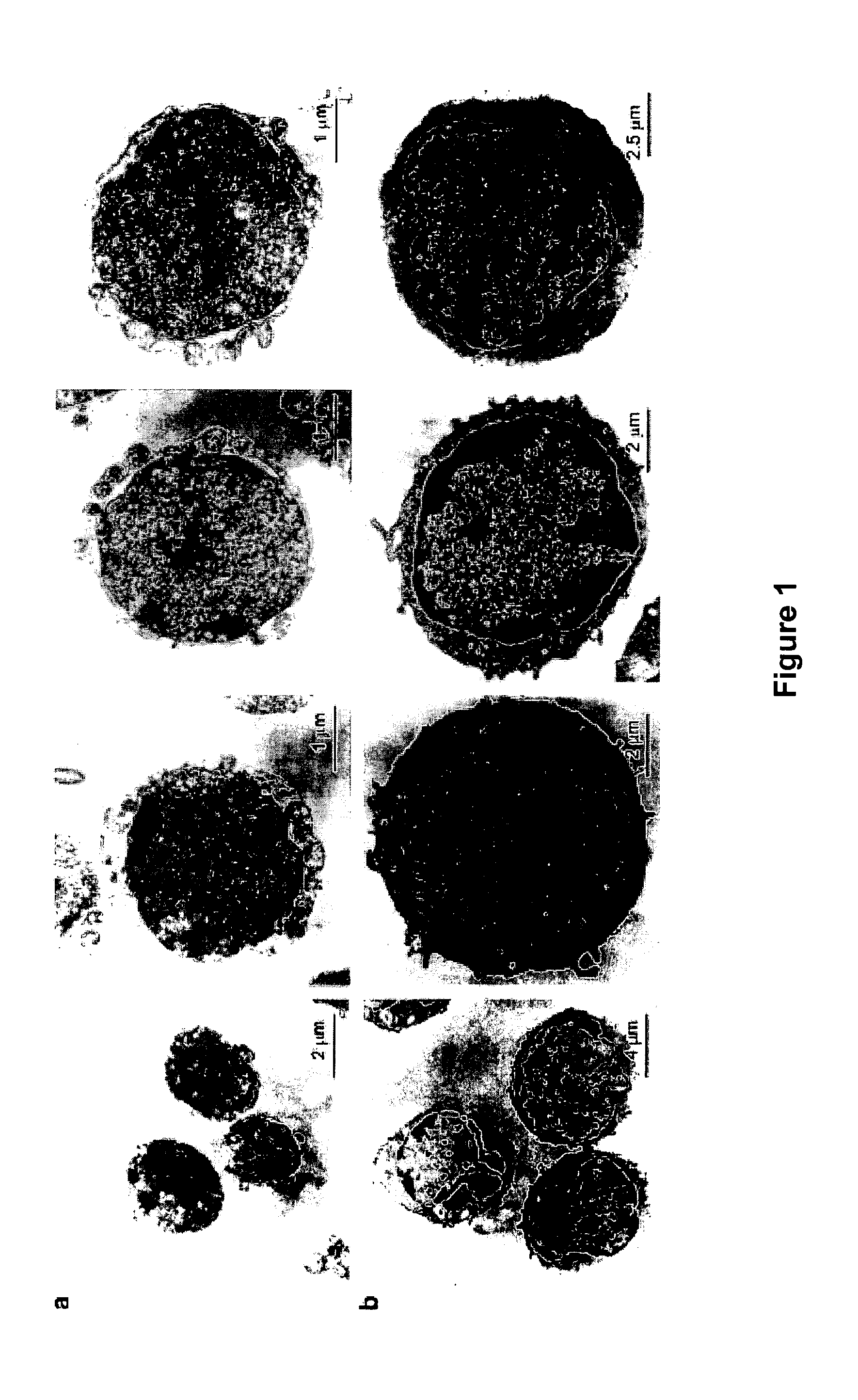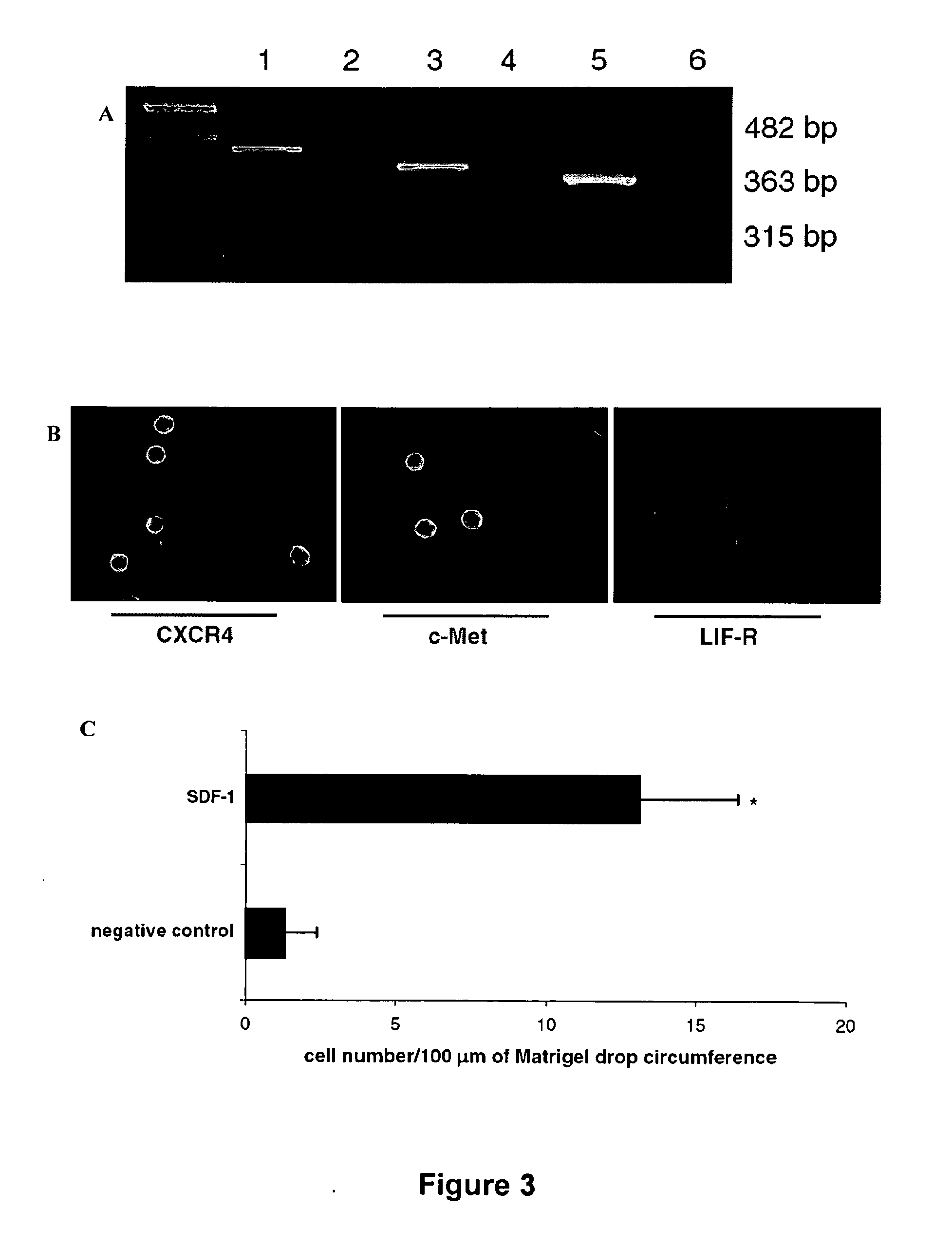Methods for isolating very small embryonic-like (VSEL) stem cells
- Summary
- Abstract
- Description
- Claims
- Application Information
AI Technical Summary
Benefits of technology
Problems solved by technology
Method used
Image
Examples
example 1
Bone Marrow Cells
[0261]Murine mononuclear cells (MNCs) were isolated from BM flushed from the femurs of pathogen-free, 3 week, 1 month, and 1 year old female C57BL / 6 or DBA / 2J mice obtained from the Jackson Laboratory, Bar Harbor, Me., United States of America. Erythrocytes were removed with a hypotonic solution (Lysing Buffer, BD Biosciences, San Jose, Calif., United States of America).
[0262]Alternatively, MNCs were isolated from murine BM flushed from the femurs of pathogen-free, 4- to 6-week-old female Balb / C mice (Jackson Laboratory) and subjected to Ficoll-Paque centrifugation to obtain light density MNCs. Sca-1+ cells were isolated by employing paramagnetic mini-beads (Miltenyi Biotec, Auburn, Calif., United States of America) according to the manufacturer's protocol.
[0263]Light-density human BMMNCs were obtained from four cadaveric BM donors (age 52-65 years) and, if necessary, depleted of adherent cells and T lymphocytes (A-T-MNC) as described in Ratajczak et al. (2004 a) 10...
example 2
Sorting of Bone Marrow-Derived Cells
[0264]For murine BM cells, Sca-1+ / lin− / CD45− and Sca-1+ / lin− / CD45+ cells were isolated from a suspension of murine BMMNCs by multiparameter, live sterile cell sorting using a FACSVANTAGE™ SE (Becton Dickinson, Mountain View, Calif., United States of America). Briefly, BMMNCs (100×106 cells / ml) were resuspended in cell sort medium (CSM), containing 1× Hank's Balanced Salt Solution without phenol red (GIBCO, Grand Island, N.Y., United States of America), 2% heat-inactivated fetal calf serum (FCS; GIBCO), 10 mM HEPES buffer (GIBCO), and 30 U / ml of Gentamicin (GIBCO). The following monoclonal antibodies (mAbs) were employed to stain these cells: biotin-conjugated rat anti-mouse Ly-6A / E (Sca-1; clone E 13-161.7) streptavidin-PE-Cy5 conjugate, anti-CD45−APCCy7 (clone 30-F11), anti-CD45R / B220-PE (clone RA3-6B2), anti-Gr-1-PE (clone RB6-8C5), anti-TCRαβ PE (clone H57-597), anti-TCRγδ PE (clone GL3), anti-CD11b PE (clone M1 / 70) and anti-Ter-119 PE (clone T...
example 3
Side Population (SP) Cell Isolation
[0267]SP cells were isolated from the bone marrow according to the method of Goodell et al. (2005) Methods Mol Biol 343-352. Briefly, BMMNC were resuspended at 106 cells / ml in pre-warmed DMEM / 2% FBS and pre-incubated at 37° C. for 30 minutes. The cells were then labeled with 5 μg / ml Hoechst 33342 (Sigma Aldrich, St. Louis, Mo., United States of America) in DMEM / 2% FBS and incubated at 37° C. for 90 minutes. After staining, the cells were pelleted, resuspended in ice-cold cell sort medium, and then maintained on ice until their sorting. Analysis and sorting were performed using a FACSVANTAGE™ (Becton Dickinson, Mountain View, Calif., United States of America). The Hoechst dye was excited at 350 nm and its fluorescence emission was collected with a 424 / 44 band pass (BP) filter (Hoechst blue) and a 675 / 20 BP filter (Hoechst red). All of the parameters were collected using linear amplification in list mode and displayed in a Hoechst blue versus Hoechst...
PUM
 Login to View More
Login to View More Abstract
Description
Claims
Application Information
 Login to View More
Login to View More - R&D
- Intellectual Property
- Life Sciences
- Materials
- Tech Scout
- Unparalleled Data Quality
- Higher Quality Content
- 60% Fewer Hallucinations
Browse by: Latest US Patents, China's latest patents, Technical Efficacy Thesaurus, Application Domain, Technology Topic, Popular Technical Reports.
© 2025 PatSnap. All rights reserved.Legal|Privacy policy|Modern Slavery Act Transparency Statement|Sitemap|About US| Contact US: help@patsnap.com



